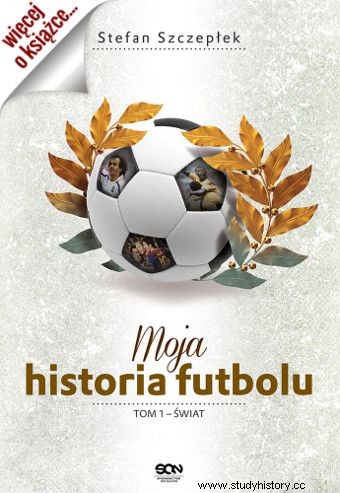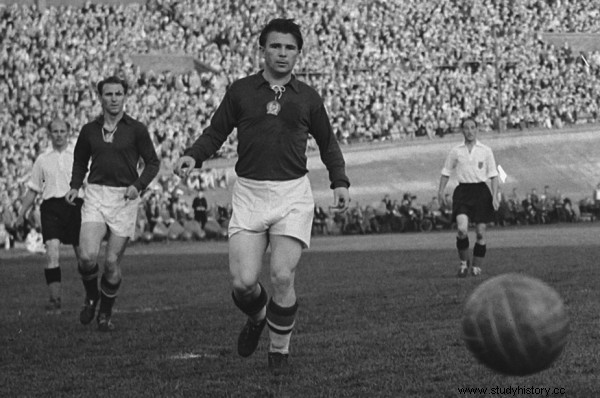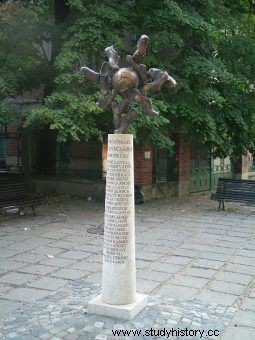When Europe was divided by the Iron Curtain, representatives of the Eastern Bloc soon understood the power of sport in the service of propaganda. The implementation of socialist ideology in football brought much better results than in the economy. The Hungarians were particularly successful in this field.
It was a real dream team, galacticos early fifties. They were called variously, most often as the "golden eleven", although the English dubbed them "Mighty Magyars". Nothing unusual. The undefeated - as it seemed to them then - the islanders played with the Hungarians twice within a year. Enraged by the home defeat (6-3), they also fell in Budapest (7-1!) And were amazed to see that someone in the world can play football better than them.
The Hungarians completely dominated the football scene in the first half of the 1950s. They were invincible for over four years, frustrating all opponents, winning all minor trophies along the way, including the Olympic Games Championship . The socialist version of football therefore seemed to triumph.
The genesis of success
The foundations for football power were built on the Danube even before the war. Football traditions there went back to the nineteenth century. In the 1930s, the local league was considered one of the strongest in Europe, and the team was already successful at that time. While we were happy in 1938 with Wilimowski's four goals in a loss against Brazil, the Hungarians reached the World Cup final!

We just won this match:August 27, 1939, Poland - Hungary 4-2 (photo:public domain).
Unlike its neighbors, in Hungary the Second World War did not stop the football development of the younger generation. For almost the entire duration of the conflict, league games were played with only minor obstacles. From this generation, the players who would later conquer the world grew up.
A union trainer can do anything!
The man who built the power of Danube football and shaped it in a socialist fashion was Gusztav Sebes. A zealous communist, an outstanding trainer, efficient organizer. As Stefan Szczepłek wrote in the book "My history of football":
Sebes stood myself precursor schools used later with successfully w other countries, especially by Valery Łobanowskiego w Dynamie Kyiv and representation USSR. No counting myself with costs, business other clubs and fate themselves footballers, created w Honvéd center training for whole Hungarian.

The article was based, inter alia, on for the book by Stefan Szczepłek "My history of football", vol. 1, "Świat" (SQN 2015).
Sebes suppressed the power of the right-wing and patriotic (Ferencváros and Ujpestu) and bourgeois (ICC) clubs and bet on Honved, which was handed over to the protective wings of the army. This is where the best Hungarian footballers found their way through a top-down regulation. Ferencváros handed over Sándor Kocsis, Zoltán Czibor and László Budai. Even the working class Vasas had to sacrifice his leader, Gyula Lorant. The young club president, later general secretary of the Hungarian Socialist Workers' Party, János Kádár, had nothing to say about it.
Socialist vision of football
With Sebes already having outstanding players and almost unlimited power over them, it was time to instill them with the appropriate ideology. Socialist football tactics created the seeds of total football:all players were subordinated to the team, and the vision of team success became more important than the whims of the individual. Each skater was responsible for both defense and attack. At a time when individual players were responsible only for specific tasks, it was an absolute novum . This is now the basis of the football alphabet.
The footballers were often organized propaganda talks with agitators so that no one would think of escaping abroad. Additionally, despite the hard work and barracks lifestyle, footballers functioned on a slightly higher standard of living than the rest of society.
However, there were those who tried to get to the West. When the promising defense attorney Sándor Szűcs was caught at the border, the court released shocking verdict: punishment death . It was a clear signal to the rest of the talented players:don't even try it! The sentence was carried out on June 4, 1951, exactly one year after the Hungarians defeated the Polish national team in Warsaw (5-2).

Nándor Hidegkuti and Ferenc Puskás had to change their names to play for the Hungarian national team (photo:Wim van Rossem / Anefo, from the Nationaal Archief collection, CC BY-SA 3.0).
Politically incorrect surnames
Many footballers have their surnames changed to sound more proletarian, which was described in detail by Stefan Szczepłek:
Dbano o clean ideological and any correct. Competitors changed surnames, to better sounded after Hungarian, a even resumes. Sebes really called myself Scharenpeck and had origin Jewish. Ferenc Puskás this Purczeld, his family was coming with German, was called go so Swabem.
Class background was extremely important. A descendant of an aristocratic family with the suspiciously sounding surname Kaltenbrunner (German for "zimnostudzieny"), he became the Hungarian "zimnostudziennym" or Hidegkutim. Additionally, Sebes recommended making a propaganda film in which the footballer's mother was presented as a brickyard worker. Thus, the presence of an outstanding dribbler-aristocrat in the socialist dream team was ideologically justified.
The crash in Bern
Great players, a disciplined and hard-working team, innovative tactics ... The Hungarians began their march to the top of the football Olympics. They quickly gained respect and began to arouse terror in the eyes of opponents and fans. It is worth mentioning that it was around the match with them that Leopold Tyrmand built the plot of the immortal "Evil". Hungarian national team - it meant something absolutely top.

It was at this stadium that the "Miracle in Bern" happened. It was demolished in 2001 (photo:Twenty-nine, public domain).
The Hungarians only lost once. Happens to the best ones. Unfortunately, it was just the final of the world championship, the most important match of the several dozen played and also won. It was supposed to be the culmination of a four-year-old full domination and control over the football world. The icing on the cake, a dot over the i.
The "Miracle in Bern", ie the victory of West Germany (3-2), was a huge shock for fans, journalists, coaches and players. The more that both teams met in the group stage and the Hungarians demolished their opponents (8-3). The world was amazed, the Hungarians furious. For a description of the mood on the Danube, see "My History of Football":
W Budapest was boiling. Runner-up the world was failure no only footballers. Power insisted that "Gold eleven ”exists thanks ago, that country they rule communists. When ta eleven lost, argument o superiority systemic a little paled. (…) Na streets Budapest came out w protest a few thousands people. Knocked over tram, set on fire a few cars. Authorities started from punishments journalists, who "fueled atmosphere success ”.

Such a monument was erected by the Hungarians to their golden eleven in Szeged (photo:Kalmár Márton, public domain).
Unwanted title
The Hungarians won the world runner-up. A title that no one in Hungary enjoyed. It sounds at least strange given the current condition of Hungarian football. To this day, the finale of 1954 is treated in Budapest as a national tragedy. The city of Bern is associated there almost as badly as Trianon, where Hungarians lost two-thirds of their country after World War I.
The "Golden Eleven" quickly disintegrated, many players stayed abroad after the events of 1956. That was the end of one of the best teams in the history of football to never win a World Championship title.
Sources:
Stefan Szczepłek, My history of football , vol. 1, World , Sine Qua Non Publishing House, Krakow 2015.
The author also used materials collected while working on his own book on the history of football.
We recommend:
The history of world football is described by a journalist who has been an eyewitness to the most important football events in the last half-century. A fascinating journey with a guide who spoke personally to Pelé, Didi, Eusébio, George Best, Franz Beckenbauer or Ferencem Puskásem , saw the goals of Diego Maradona at Estadio Azteca and the famous Zinédine Zidane volley at Hampden Park , survived the tragedy at the stadium Heysel and the joy of Manchester United after winning the Champions League final with Bayern at Camp Nou .
From the birth of football in its modern form in the British Isles in the mid-19th century to the World Cup in Brazil. From the inception of FIFA to the recent times, in which Leo Messi and Cristiano Ronaldo they have become more popular than many crowned heads. Who played the first match in Antarctica? Who made football flourish in Brazil? Why do many clubs around the world have English names?
Stefan Szczepłek he watched thousands of matches on several continents, saw the World Cup and the European Championship live. He conducted hundreds of interviews with footballers, coaches, activists and referees. He chose what, in his opinion, is the most interesting in football and what has to do with politics, culture and science. This book takes us from stadium to stadium, from joy to drama. And - as is the guide - it shows souvenirs and trophies.
In My Football Story in addition to the unique photos, there are reproductions of tickets and programs from the most famous matches as well as photos of the original t-shirts and shoes of the stars - often with their signatures. It's all from the author's private collection, the only one in Poland and one of the largest in Europe. Reading and watching this book, you have the impression that it is also our story, only Stefan Szczepłek he helped us systematize it, bring it closer and explain it. There has never been such a book on football in Poland before.
